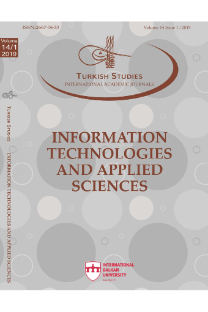Binalarda Enerji Verimliliği için Gerekli Algılayıcıların Özgün Olarak Geliştirilmesi ProjesiTekno-Ekonomik Analizi
Techno-Economic Analysis of the Indigenous Sensor Development for Energy Efficient BuildingsResearch Project
___
- Bogdan A., Chantal D., Marina E., Joana M., Ingeborg N., Oliver R. (2011). Europe’s buildings under the microscope, A country-by-country review of the energy performance of buildings. Buildings Performance Institute Europe (BPIE).
- BOTAS (2017). BOTAS Sektör Raporu. Erişim Adresi: https://www.botas.gov.tr/uploads/galeri/5c6ded9d4cd5f20.02.2019sektorap_2016.pdf
- CK Elektrik (2020). CK Elektrik Fatura Bedeli. Erişim Adresi: https://www.ckbogazici.com.tr/
- Cohen, R. & Bordass, W. & Field, J. (2004). Energy performance of non domestic buildings: closing the credibility gap. In Building Performance Congress.
- Copenhagen Economics (2012). Multiple Benefits of Investing in Energy Efficient Renovation of Buildings; CE: Copenhagen, Denmark.
- DIN-Deutsches Institut für Normung e.V. (2007). DIN EN 15232: Energieeffizienz von Gebäuden Einfluss von Gebäudeautomation und Gebäudemanagement, Deutsche Fassung EN 15232:2007. Berlin, Germany. Erişim Adresi: https://www.zvei.org/fileadmin/user_upload/Verband/Fachverbaende/Elektroinstallationssy steme/Studie_Energieeffizienz_durch_Gebaeudeautomation/Kurzfassung-ZVEI-Studie- Energieeffizienz-durch-Gebaeudeautomation.pdf
- Doğan İ., G. (2020). Güneş Enerjisi Uygulamaları, Bilişim yayınları, 26-27, 88, 119.
- Dünya Bankası (2020a). World Bank. Erişim Adresi: https://data.worldbank.org/indicator/SP.POP.TOTL?locations=TR, Erişim Tarihi: 10.06.2020.
- Dünya Bankası (2020b). World Bank. Erişim Adresi: https://data.worldbank.org/indicator/NY.GDP.MKTP.CD?locations=TR, Erişim Tarihi: 10.06.2020.
- Dünya Bankası (2020c). World Bank. Erişim Adresi: https://data.worldbank.org/indicator/EN.ATM.CO2E.PC?end=2014&locations=TR&start= 1980, Erişim Tarihi: 10.06.2020.
- EC (2011). European Comission – Energy. Erişim Adresi: www.ec.europa.eu/energy/efficiency/buildings/buildings_en.htm
- EC (2011a). A Roadmap for moving to a competitive low carbon economy in 2050, SEC (2011) 289 final. Erişim Adresi: https://ec.europa.eu/clima/sites/clima/files/strategies/2050/docs/roadmap_fact_sheet _en.pdf
- EC (2012). Commission Delegated Regulation (EU) No 244/2012 of 16 January 2012 Supplementing Directive 2010/31/EU of the European Parliament and of the Council on the Energy Performance of Buildings by Establishing a Comparative Methodology Framework for Calculating Cost-Optimal Levels of Minimum Energy Performance Requirements for Buildings and Building Elements. EUR-Lex—32012R0244—EN— EUR-Lex. Available online: https://eur-lex.europa.eu/legalcontent/ EN/TXT/?uri=uriserv:OJ.L_.2012.081.01.0018.01.ENG (accessed on 13 January 2019).
- EC (2019). European Commision-Clean Energy for All Europeans. ISBN: 978-92-79-99835-5. DOI: 10.2833/9937. Erişim Adresi: https://op.europa.eu/en/publication-detail/- /publication/b4e46873-7528-11e9-9f05-01aa75ed71a1/languageen? WT.mc_id=Searchresult&WT.ria_c=null&WT.ria_f=3608&WT.ria_ev=search
- EMO (2019). TMMOB Elektrik Mühendisleri Odası. Erişim Adresi: http://www.emo.org.tr/genel/bizden_detay.php?kod=128261&tipi=5&sube=0
- EİGM (2020). Enerji İşleri Genel Müdürlüğü Denge tabloları, Erişim Adresi: https://www.eigm.gov.tr/tr-TR/Denge-Tablolari/Denge-Tablolari, Erişim Tarihi: 10.06.2020.
- EUROSTAT (2020a). Oil and Petroleum Products-a statistical overview. Erişim Adresi: https://ec.europa.eu/eurostat/statisticsexplained/ index.php?title=Oil_and_petroleum_products_- _a_statistical_overview#Oil_imports_dependency
- EUROSTAT (2020b). Oil and Petroleum Products-a statistical overview. https://ec.europa.eu/eurostat/statisticsexplained/index.php?title=Oil_and_petroleum_produ cts_-_a_statistical_overview#Oil_imports_dependency
- Gazbir (2018) Türkiye Doğal Gaz Dağıtıcıları Birliği 2018 Yılı Doğalgaz Dağıtım Sektörü Raporu. Erişim Adresi: https://www.gazbir.org.tr/uploads/page/2018-Dogal-Gaz-Sektor- Raporu.pdf.
- Gökçe H. U., Gökçe K. U. (2013) Integrated system platform for energy efficient building operations. Journal of Computing in Civil Engineering. 10.1061/(ASCE)CP.1943- 5487.0000288 (5 Jan 2013) SCI A.
- Gökçe, C. ve Erol, M. (2020) Türkiye’de Tasarruf Açığı ve Enerji Açığının Ekonomik Büyüme ile İlişkisi: Nedensellik Analizi. Dumlupinar Üniversitesi Sosyal Bilimler Dergisi. 64, 102- 122;2020. E-ISSN: 2587 005X http://dergipark.gov.tr/dpusbe
- Gökçe, H. U ve Gökçe K. U. (2011). Multi Dimensional Information Management Platform for Wireless Embedded Monitoring of Building Performance Data. Proceedings of the 11th International Conference on Construction Applications of Virtual Reality, Weimar, Germany. ISBN: 978-3-86068-458-0.
- IEA (2013). International Energy Agency. Energy Efficiency Market Report. Erişim Adresi: https://www.iea.org/news/from-hidden-fuel-to-worlds-first-fuel. Erişim Tarihi: 19.08.2020.
- IEA (2020). International Energy Agency. Erişim Adresi: https://www.iea.org/countries/turkey. Erişim Tarihi: 10.06.2020.
- İGDAŞ (2020). Perakande Satış. Erişim Adresi: https://igdas.istanbul/perakende-satis/
- ISO (2019a). International Standardisation Organisation. ISO 13790. Available online: https://www.iso.org/standard/41974.html (accessed on 13 January 2019).
- ISO (2019b). International Standardisation Organisation. ISO 52016-1:2017. https://www.iso.org/standard/65696.html (accessed on 13 January 2019).
- Itard, L., Meijer, F., Vrins, E., & Hoiting, H. (2008). Building renovation and modernisation in Europe: State of the art review. ERABUILD. Nederlands: TU Delft, 2008. Erişim Adresi: http://iibw.at/documents/2008%20OTB%20TU%20Delft.%20Erabuild%20Building.%20R enovation%20Europe.pdf
- Lauer (2020). Thermalnet Methodology Guideline On Techno Economic Assessment. Erişim Adresi: https://ec.europa.eu/energy/intelligent/projects/sites/ieeprojects/ files/projects/documents/thermalnet_methodology_guideline_on_techno_economi c_assessment.pdf
- OME (Observatoire Méditerranéen de l’Energie). (2014). Mediterranean Energy Perspectives – TURKEY.http://www.tenva.org/wp-content/uploads/2014/09/MEP-Turkey-Executive-Summary- English.pdf
- UBA (2020). Umweltbundesamt. Spezifische Emissionsfaktoren für den deutschen Strommix. Erişim Adresi: https://www.umweltbundesamt.de/themen/luft/emissionen-vonluftschadstoffen/ spezifische-emissionsfaktoren-fuer-den-deutschen. Erişim Tarihi: 19.08.2020.
- Price, L. (2006). Sectoral Trends in Global Energy Use and Greenhouse Gas Emissions. Lawrence Berkeley National Laboratory. USA. Erişim Adresi: https://www.osti.gov/servlets/purl/888753
- Rogers, E.A.; Junga, E. (2017). Using Intelligent Efficiency to Collect and Analyze Nonenergy Benefits Information; Report IE1702 of the American Council for an Energy-Efficient Economy (ACEEE); ACEEE: Washington, DC, USA.
- SBB (2018). Strateji ve Bütçe Başkanlığı 10’uncu Kalkınma Planı. Erişim Adresi: http://www.sbb.gov.tr/wp-content/uploads/2018/11/Onuncu-Kalk%C4%B1nma- Plan%C4%B1-2014-2018.pdf.
- TÜİK (2019). Türkiye İstatistik Kurumu. Erişim Adresi: http://www.tuik.gov.tr/PreTablo.do?alt_id=1055. Erişim Adresi: 19.08.2020.
- Thema, J.; Rasch, J.; Suerkemper, F.; Thomas, S. (2018). Multiple Impacts of Energy Efficiency in Policy-Making and Evaluation. Combi-Project D8.2 Policy Report on COMBI Results. Available online: https://combiproject. eu/wpcontent/ uploads/D8.2_COMBI_policy_report.pdf (accessed on 31 December 2018).
- UNFCCC (2018). United Nations Climate Change Annual Report 2017. ISBN: 978-92-9219-175- 7. https://unfccc.int/resource/annualreport/media/UN-Climate-AR17.pdf
- VDMA-German Engineering Federation (2008). Energy-efficiency of Buildings. Germany. Beuth Verlag GmbH 2007, pp. 79.
- Washan, P.; Stenning, J.; Goodman, M. (2014). Building the Future: Economic and Fiscal Impacts of Making Homes Energy Efficient; Verco and Cambridge Econometrics: Cambridge, UK.
- ISSN: 2667-5633
- Yayın Aralığı: 4
- Başlangıç: 2006
- Yayıncı: ASOS Eğitim Bilişim Danışmanlık Otomasyon Yayıncılık Reklam Sanayi ve Ticaret LTD ŞTİ
MRIKardiyak MR Görüntülerinde Sol Kulakçık Bölütlenmesi İçin Derin Öğrenme Tabanlı Hibrit Model
Öğrencilerin 21. Yüzyıl Öğrenme Becerileri İçin Veri Toplama Aracı: Geçerlik ve Güvenirlik Çalışması
Görsel Sanatlar-Yapay Zekâ İş Birliğine Yönelik İşlevsel Sınıflandırma Derlemesi
Hasan Ufuk GÖKÇE, Kamil Umut GÖKÇE
Kamil Umut GÖKÇE, Hasan Ufuk GÖKÇE
Müzik Eğitiminin Yeni Yüzü: Dijital Teknopedagojik Müzik (DiTeM) Eğitimi
